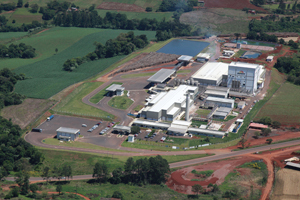High feed costs cause shifts in Brazilian poultry market

Price of chicken in Brazil is on the rise, as the huge hike in the price of feed works its way through. Per capita, domestic consumption is set to fall this year. Our correspondent in the country analyses the effects of the current turmoil in the poultry market of the largest exporter in the world.
A severe drought in the south of Brazil, where two thirds of the 13 million tonnes of chicken produced each year is processed, cut nine million tonnes from the 2011/12 soybean crop. This, coupled with the recent dry weather in the United States, has caused the world price of soybeans to almost double and is encouraging record exports of the oilseed from Brazil. About 23 million tonnes of soybean meal is used each year as feed by the poultry, pork and dairy cattle industries in Brazil. But there are fears that record exports could cause soybean meal to run out in Brazil before the end of this year.
The severe drought in the south and in the north east also cut the summer maize crop. But this has been more than compensated for by an all time record winter maize crop of 38 million tonnes, most of that grown in the centre west. As a result, a record 73 million tonnes of maize will be produced in Brazil this year.
The poultry and pork industries in the region already consume much more maize than is produced locally. Millions of tonnes have to be taken up to 1.500 km by truck from the centre west. Very little is still used there, despite a few integrated chicken and pork installations having been built in the region in recent years, which take advantage of cheap feed. Faced with this difficult situation, which will gradually worsen as the year progresses, the poultry industry has called on the government to take steps to prevent what it fears will be a 10% reduction in the output of chicken this year.
Brazil’s poultry industry has had a difficult time in the past few years. To attract foreign investors, some of the world’s highest interest rates were available for several years, which resulted in the currency, the real, gaining 40% against the US dollar between 2005 and the middle of last year. To maintain revenues in local currency, in which most costs are incurred, the poultry processors raised the price of the meat they exported. The effect was that some ground was lost to exports from the United States and other producers, notably Thailand and Argentina.
Another problem for the poultry industry is that there is a surplus of beef in Brazil at the moment, so red meat is relatively cheap. Farmers were encouraged by high beef prices of recent years to hold onto cows and breed more calves. But costly Brazilian beef has been priced out of many markets, and exports have stagnated. Although more chicken than beef is now sold in Brazil, whenever possible Brazilians prefer beef. The relatively low cost of beef will make it difficult for chicken processors to increase prices by as much as is necessary.
Company shifts The situation is further complicated by the fact that a major re-structuring of the industry has taken place in the past four years, since Sadia, which had made unwise hedging decisions, found itself having to pay more than $2 billion to banks in penalties As a result of this, the two major players, Sadia and Perdigao, were forced to merge to form Brasil Foods. Following concern by the Competition Commission (Cade) that Brasil Foods had a virtual monopoly for many high value processed products, the Marfrig company, which bought Seara (poultry and pork processing) from Cargill a few years ago, has taken control of some Sadia and Perdigao assets. These include further processing and packaging plants. Following the decision by the troubled Doux company to leave Brazil, the JBS meat packing company, the world’s largest, has recently taken control of that company’s assets in Brazil. JBS, which a few years ago bought the Pilgrims Pride poultry company in the United States, has long wanted to get involved in processing poultry in Brazil, where the company is the largest processor of beef, and a leading producer of pork. JBS has been loaned several billion dollars by Brazil’s National Development Bank, which allowed it to embark on a buying spree overseas and consolidate in Brazil. Because of this, it seems that the government put pressure on JBS to assume control of Doux, rather than let the company be taken over by a foreign company such as Tyson, which has been rather low key in Brazil until now. |













